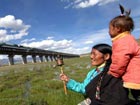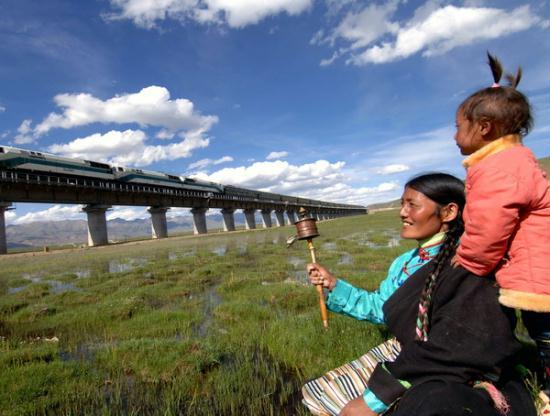| Videos | ? Latest |
|
? Feature | ? Sports | ? Your Videos |
Qinghai-Tibet Railway: World's highest and longest plateau railway

 0 Comment(s)
0 Comment(s) Print
Print E-mail
CNTV, July 18, 2011
E-mail
CNTV, July 18, 2011
Wild animals, such as Tibetan antelopes and Black Necked cranes, together with gorgeous lakes and snow-covered mountains...Want to see them all at the same time? Riding on the world's highest and longest plateau railway, which connects Tibet Autonomous Region with other parts of China will make the wish come true.
|
|
|
The Qinghai-Tibet Railway, the world's highest plateau railway, has stood safety and environmental tests while boosting regional economic growth over the past five years. |
The Qinghai-Tibet Railway, the world's highest plateau railway, has stood safety and environmental tests while boosting regional economic growth over the past five years.
The rail link of nearly 2000 kilometers running from Golmud in northwestern Qinghai Province to Tibet's regional capital Lhasa has transported more than 41 million passengers and 180 million tonnes of cargo since it opened on July 1st, 2006. It passes through three national nature reserves including Hoh Xil, a major habitat for the critically-endangered Tibetan antelope.
Perched at an average altitude of 4,500 meters, Hoh Xil reserve contains the largest area of uninhabited land in China and is dubbed the country's "last heaven for wild animals".
Some people had thought the roaring trains might scare away the antelopes and disrupt their breeding pattern, but in fact their numbers in Hoh Xil region have increased from around 50,000 in 2006 to more than 60,000 today.
|
|
|
The Qinghai-Tibet Railway, the world's highest plateau railway, has stood safety and environmental tests while boosting regional economic growth over the past five years. |
Zong Ga, official of Tibet Forestry Bureau, said, "The Qinghai-Tibet railway has no negative impact on wild life animals here, such as Tibetan antelopes and Black Necked cranes. There is no harmful effect on important natural reserve wetlands either. We have built a number of green passageways exclusively for animals. And the antelopes have already adapted themselves to the railway as have wild birds. By and large, the number of wild animal in Tibet is enjoying recovery and growth."
All the stations use clean energy to minimize emissions. Railway authorities have worked to preserve and expand vegetation along the route, which is surrounded by millions of square meters of trees.
In 2008, the railway was named as an "environment -friendly project" in China's top environment awards.
The rail link to Lhasa is a starting point towards a more comprehensive railway network in underdeveloped western China.
Go to Forum >>0 Comment(s)
 Add your comments...
Add your comments...
- User Name Required
- Your Comment
- Racist, abusive and off-topic comments may be removed by the moderator.







